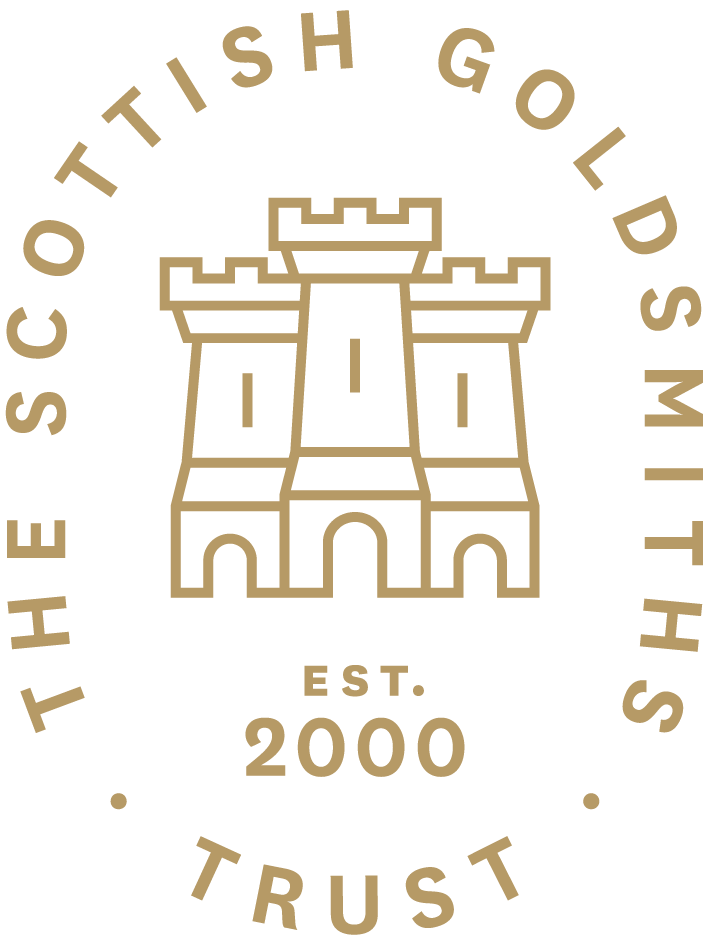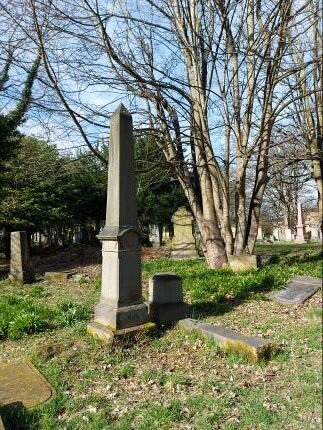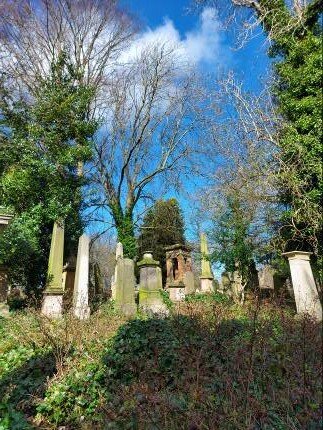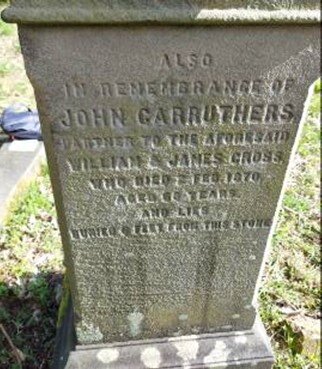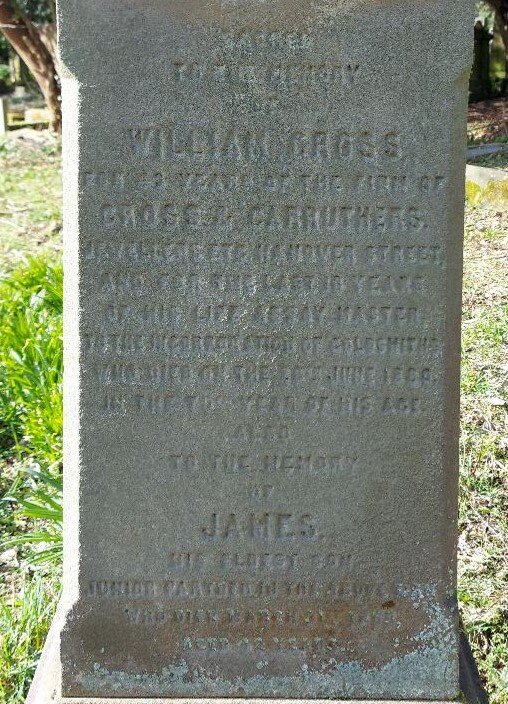The Assay Master's Monument
Written by George Dalgleish
Below is a story written by George Dalgleish, Member of The Incorporation of Goldsmiths. George has enjoyed an extensive career as a museum curator, with a lifelong passion for Scottish history and material culture. A graduate of Edinburgh University, he retired as Keeper of the Scottish History and Archaeology Department of National Museums Scotland in 2016, after a 37-year career there. Our sincere thanks to George for bringing us this fascinating story.
In these strange and disturbing times, most of us have been forced to look closer to home than normal for places to take our daily permitted exercise. For me, this has involved voyages of urban discovery that have unearthed parts of Edinburgh that have been previously completely unknown, despite having lived here for 50 years and despite several of them being on my own doorstep. One of the most intriguing, atmospheric, and fascinating of these is Warriston Cemetery, just off Inverleith Row, at the end of Warriston Gardens.
This once manicured and prestigious last resting place of many of Edinburgh’s most prominent Victorian citizens, is gradually being reclaimed by nature and is a haven for wildlife of all kinds. Now cared for and made accessible to walkers by the hard graft of the Friends of Warriston Cemetery, it has a surprising number of connections with past members of The Incorporation of Goldsmiths of Edinburgh.
The first, albeit somewhat tangential, link is that the Cemetery was built on land feued (granted) from the Governors of Heriot’s Hospital, the body responsible for administering the astonishingly generous bequest by George Heriot (1563-1624) to his native town upon his death. As goldsmith and jeweller to King James VI and his Queen Anne, Heriot made a fortune, and left a considerable portion of it to care for ‘puir faitherless bairns, friemenes sons of that Toune of Edinburgh’. (Heriot himself is buried at St Martins in the Field, London, but his father, also George, has a very fine monument in Greyfriars Kirkyard, Edinburgh). By the 18th century, the governors of his bequest owned many acres of land in and around the town, including the large tract running to the east of Inverleith Row, from the Water of Leith, north to Ferry Road. Some nine acres of this land was feued (granted) to the Edinburgh Cemetery Co in 1840 (with more acquired later), and their Cemetery was opened for business in June 1843. Warriston was the first commercial ‘Garden Cemetery’ in Scotland, part of a movement in Britain and Europe that sought to deal with the insanitary and dangerous problems caused by massive overcrowding of urban graveyards. The first example was the magnificent Père Lachaise in Paris, opened in 1804, to be followed in London by Kensal Green in 1833 and the spectacular Highgate in 1839. Warriston was designed by the architect David Cousin, who had won the Cemetery Company’s architectural competition for a ‘most improved and ornamental cemetery’. [Cousin had previously been unsuccessful in the competition to design the Scott Monument. Somewhat curiously, the artist responsible for the interior decoration of Walter Scott’s home Abbotsford, David Ramsay Hay, is buried within a few yards of the subject of this blog, where he has one of the more memorable of Warriston’s monuments.]
Warriston Cemetery, From Old and New Edinburgh, by James Grant, Edinburgh, 1883
As a commercial enterprise, from the outset, Warriston was intended to attract those with the wherewithal to pay its considerable lair and monument fees. It was advertised as having a ‘very desirable location’, while its Gothic catacombs were ‘well lighted, airy and dry’! The Scotsman waxed lyrical about its attractions in September 1846: ‘Every visit we pay this beautiful resting place for the dead, we are more delighted with its appearance’. Along with the general layout, the monuments raised to the dead were also praised for their elegance as ‘…a remarkable contrast to the skulls and crossbones with which our ancient graveyards were wont to be plentifully decorated’. And indeed, the range of monuments and grave markers provide an illustrative textbook in stone of the changing tastes in artistic styles of the 19th century, from neoclassical, through Gothic and Scots Baronial to the Celtic Revival. It is remarkable as well for its range of inhabitants: lawyers, judges, military men, medicos and particularly architects, artists and craftsmen…a roll call of Edinburgh’s middle classes.
Cross and Carruthers’ Monument, Warriston Cemetery, Edinburgh
Warriston Cemetery, during lockdown 2021
So finally we come to some previous members of the Incorporation who found their final resting place among the greenery of Warriston. Robert Kirk Inches, founder of Hamilton & Inches, and sometime Lord Provost of Edinburgh, shares this peaceful spot with several members of the extensive Kirkwood clan of goldsmiths (and they may feature in a further installment of this blog!).
It was, however, a rather severe, plain obelisk erected to mark the final resting place of a former Assay Master and Deacon that first caught my eye. It also commemorates a long-lived and closely knit family firm of goldsmiths and jewellers, which operated in Edinburgh from 1827 to 1870, Messrs Cross & Carruthers. Sitting in Section F, not far from the east gate of the cemetery (a layout map can be downloaded from the Friends website) it is a tall tapering sandstone obelisk set on a rectangular cushioned base.
The inscriptions are worth recording in full:
‘SACRED / TO THE MEMORY / OF / WILLIAM CROSS / FOR 43 YEARS OF THE FIRM OF / CROSS & CARRUTHERS / JEWELLLERS ETC, HANNOVER STREET, / AND FOR THE LAST 16 YEARS / OF HIS LIFE ASSAY MASTER / TO THE INCORPORATION OF GOLDSMITHS / WHO DIED ON THE 26th JUNE 1880 / IN THE 79th YEAR OF HIS AGE.
ALSO / TO THE MEMORY / OF / JAMES / HIS ELDEST SON / JUNIOR PARTNER IN THE ABOVE FIRM / WHO DIED MARCH 31st 1869 / AGED 42 YEARS.’
Reverse
‘ALSO / IN REMEMBRANCE OF / JOHN CARRUTHERS / PARTNER TO THE AFORESAID / WILLIAM & JAMES CROSS / WHO DIED 2 FEB, 1870, / AGED 68 YEARS / AND LIES / BURIED 6 FEET FROM THIS STONE .’
So, what do we know about these three past members of the Incorporation? Our principal here is William Cross, born on 5 September 1801, the son of another William Cross. He was apprenticed for the usual seven years to Alexander Brodie, on 9 June 1814, only one month after his master became a freeman himself. Rather surprisingly, the only other apprentice that Brodie took on was one John Carruthers, son of another John, a cabinetmaker in Edinburgh, who was apprenticed on the same day as William Cross, starting a professional and personal connection between the two that was to last until they ended up interred in Warriston!
Neither Cross nor Carruthers completed their time with Alexander Brodie. In November 1817 Brodie left Edinburgh, for some unspecified reason, and therefore both his apprentices had to be transferred to other masters; Cross to William and Patrick Cunningham, while Carruthers was transferred to John Caw. The young men completed their indentures on 9 June 1821. Where they worked for the next few years is unknown, but presumably they were gaining experience as journeymen with some established firms. The professional connection became more personal on 10 November 1825, when William Cross married his first wife, Louisa Carruthers, presumably John’s sister.
A year later William and John established the firm of Cross and Carruthers, and started sending in items for assay, which they continued to do until 1869. The firm appears in the Edinburgh Post Office Directories, firstly at 17 Leith Walk in 1827, moving to 21 Elm Row in 1828 and remaining there until 1840, when they moved to various addresses in Hanover Street. They describe themselves variously as jewellers, working jewellers, manufacturing jewellers and seal engravers. For one year, 1833-4, they seem to have had premises at 78 Princes Street, as well as at Elm Row. This did not last long and in 1841 they moved their business and home addresses to Hanover Street, north of George Street.
It is difficult to gauge the extent and success of their business. Certainly, the appearance of their work in the Assay Office Duty Books does not suggest a thriving trade: in their first 10 years they have just 20 entries, mainly for snuff boxes, the largest of which weighed 6 ounces, and their largest consignment in this period was for 18 dessert knives, weighing 17 ounces. This contrasts markedly with most of the larger firms, such as Elder & Co who regularly sent in parcels of 100 ounces. Clearly Cross and Carruthers had other strings to their bow in order to make a living. We get an inkling of this from an advert they placed in the 1845-6 Directory, when they were now at 50 North Hanover Street: as well as jewellers they were ‘Dealers in Jewellery, Watches, Antique India China (sic) and Cabinets, Antique and Modern Paintings etc’ with a separate ‘Picture Room’ at no. 47! They seem to have been reasonably successful in their diversified enterprises as, despite continuing to put very few items in for assay, they maintained their relatively prestigious address until the partnership came to an end (see below).
Advert from Edinburgh Post Office Directory, 1845-6
We can also glean a little about their personal lives. In 1827 a son, James, was born to William and Louisa Cross, and was baptised in St Mary’s Catholic Church on 22 September of that year. A daughter, Willamina, arrived in 1830, but unfortunately it looks as though Louisa died sometime before 1834, when we find William marrying for a second time, to Jacobina Ballantyne, on 17 April in South Leith Parish Church. By 1841, both the Cross family and John Carruthers were living in Hanover Street. William Cross was obviously the senior partner in the firm and certainly had a more prominent position in the Incorporation: he became a freeman in September 1839, having been admitted as a burgess two weeks before, and was elected Deacon 1855-7. He took on his son James as an apprentice on 14 August 1841. After finishing his time with a Mr. Kirkwood, James joined the family firm, which continued as Cross and Carruthers until 1863. William Cross had been elected deacon again in 1863 but resigned in January 1864 to take up the position of Assay Master, which he retained, as we have seen from his monument, until his death in 1880. Presumably, with Cross now a paid official of the Incorporation, he withdrew from the business. The firm changed name to Carruthers & Cross from then until 1869, reflecting the fact that John Carruthers was now senior partner and James Cross the junior. Sadly, this did not last for long, as James died in 1869, aged 42, having enjoyed the status of burgess and freeman for only 4 years, while his uncle John, followed him into the ground at Warriston only a year later in February 1870. William finally joined them 10 years later, at which time, this rather fine monument was erected to commemorate an enduring family firm of Edinburgh goldsmiths and jewelers.
I hope this little excursion into the delightfully overgrown (and, yes, slightly spooky) Warriston Cemetery might have inspired some of you to take a look around your local graveyard for evidence of the fascinating individuals who contributed to the craft in years gone by.
Most of the biographical details have been gleaned from the Incorporation’s digital archive, a remarkable and extensive repository of information on Scottish goldsmiths, silversmiths and jewellers, past, present and, hopefully, future.
